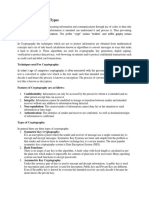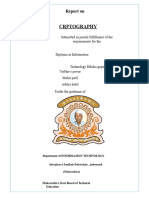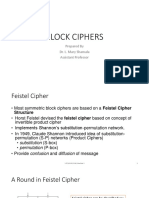Cryptography
Cryptography is technique of securing information and communications through use of codes so that
only those person for whom the information is intended can understand it and process it. Thus
preventing unauthorized access to information. The prefix “crypt” means “hidden” and suffix “graphy”
means “writing”. In Cryptography the techniques which are use to protect information are obtained
from mathematical concepts and a set of rule based calculations known as algorithms to convert
messages in ways that make it hard to decode it. These algorithms are used for cryptographic key
generation, digital signing, verification to protect data privacy, web browsing on internet and to protect
confidential transactions such as credit card and debit card transactions.
Techniques used For Cryptography: In today’s age of computers cryptography is often associated
with the process where an ordinary plain text is converted to cipher text which is the text made such
that intended receiver of the text can only decode it and hence this process is known as encryption. The
process of conversion of cipher text to plain text this is known as decryption.
Features Of Cryptography are as follows:
1. Confidentiality: Information can only be accessed by the person for whom it is intended and no
other person except him can access it.
2. Integrity: Information cannot be modified in storage or transition between sender and intended
receiver without any addition to information being detected.
3. Non-repudiation: The creator/sender of information cannot deny his intention to send information
at later stage.
4. Authentication: The identities of sender and receiver are confirmed. As well as destination/origin
of information is confirmed.
Types Of Cryptography: In general there are three types Of cryptography:
1. Symmetric Key Cryptography: It is an encryption system where the sender and receiver of
message use a single common key to encrypt and decrypt messages. Symmetric Key Systems are
faster and simpler but the problem is that sender and receiver have to somehow exchange key in a
secure manner. The most popular symmetric key cryptography system are Data Encryption
System(DES) and Advanced Encryption System(AES).
2. Hash Functions: There is no usage of any key in this algorithm. A hash value with fixed length is
calculated as per the plain text which makes it impossible for contents of plain text to be recovered.
Many operating systems use hash functions to encrypt passwords.
3. Asymmetric Key Cryptography: Under this system a pair of keys is used to encrypt and decrypt
information. A receiver’s public key is used for encryption and a receiver’s private key is used for
decryption. Public key and Private Key are different. Even if the public key is known by everyone
the intended receiver can only decode it because he alone know his private key. The most popular
asymmetric key cryptography algorithm is RSA algorithm.
Applications Of Cryptography:
1. Computer passwords: Cryptography is widely utilized in computer security, particularly when
creating and maintaining passwords. When a user logs in, their password is hashed and compared to
the hash that was previously stored. Passwords are hashed and encrypted before being stored. In this
technique, the passwords are encrypted so that even if a hacker gains access to the password
database, they cannot read the passwords.
2. Digital Currencies: To safeguard transactions and prevent fraud, digital currencies like Bitcoin also
use cryptography. Complex algorithms and cryptographic keys are used to safeguard transactions,
making it nearly hard to tamper with or forge the transactions.
3. Secure web browsing: Online browsing security is provided by the use of cryptography, which
shields users from eavesdropping and man-in-the-middle assaults. Public key cryptography is used
by the Secure Sockets Layer (SSL) and Transport Layer Security (TLS) protocols to encrypt data
sent between the web server and the client, establishing a secure channel for communication.
� Steganography
Steganography is an approach that facilitates concealing of a message that is to be kept secret inside other
message. This result is the concealment of the secret message itself.
Steganography approach can be used to images, a video file or an audio file. Generally, however,
steganography is written in characters such as hash marking, but its usage inside images is also common.
At any rate, steganography secure from pirating possess materials as well as aiding in unauthorized
viewing.One use of steganography such as watermarking which hides copyright data within a watermark
by overlaying documents not simply detected by the naked eye. This avoids fraudulent actions and
provides copyright protected media more protection.The main goal of steganography is to communicate
securely in a completely indistinguishable manner and to prevent drawing suspicion to the transmission
of a hidden information.It is not to maintain others from understanding the hidden information, but it can
maintain others from thinking that the information even exists. If a steganography method generate
someone to suspect the carrier channel, thus the method has failed.
The basic model of steganography includes Carrier, Message and Password. Carrier is also called a
cover-object, which the message is installed and serves to hide the existence of the message.
Message is the information that the sender wants to remain it confidential. It can be plain text, ciphertext,
other image, or anything that can be installed in a bit stream including a copyright mark, a covert
communication, or a serial number.
Password is called a stego-key. It can provide that only recipient who understand the correlating
decoding key will be capable to extract the address from a coverobject. The cover-object with the
secretly installed message is then known as the stego-object.
Recovering address from a stego-object needed the coverobject itself and a correlating decoding key if a
stego-key was utilized during the encoding phase. The initial image may or may not be needed in most
applications to extract the message.
How is it different from cryptography?
Cryptography and steganography are both methods used to hide or protect secret data. However, they
differ in the respect that cryptography makes the data unreadable, or hides the meaning of the data,
while steganography hides the existence of the data.
In layman’s terms, cryptography is similar to writing a letter in a secret language: people can read it,
but won’t understand what it means. However, the existence of a (probably secret) message would be
obvious to anyone who sees the letter, and if someone either knows or figures out your secret language,
then your message can easily be read.
If you were to use steganography in the same situation, you would hide the letter inside a pair of socks
that you would be gifting the intended recipient of the letter. To those who don’t know about the
message, it would look like there was nothing more to your gift than the socks. But the intended
recipient knows what to look for, and finds the message hidden in them. Similarly, if two users
exchanged media files over the internet, it would be more difficult to determine whether these files
contain hidden messages than if they were communicating using cryptography.Cryptography is often
used to supplement the security offered by steganography. Cryptography algorithms are used to encrypt
secret data before embedding it into cover files.
There are several suitable carriers below to be the cover-object which are as follows −
Network Protocols such as TCP, IP and UDP.
Audio that using digital audio formats including wav, midi, avi, mpeg, mpi and voc.
File and Disk that can hides and append documents by utilizing the slack space.
Text including null characters, only alike morse code such as html and java.
� Images file including bmp, gif and jpg, where they can be both color and grayscale.
In general, the information hiding procedure extracts redundant bits from coverobject. The process
includes two steps which are as follows −
Recognition of redundant bits in a cover-object. Redundant bits are those bits that can be changed
without corrupting the feature or failure the principle of the cover-object.
The embedding procedure choose the subset of the redundant bits to be restored with data from a
secret message. The stego-object is produced by restoring the selected redundant bits with message
bits.





















































































